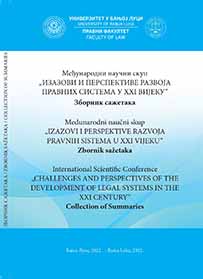PRAVNA ZAŠTITA PRAVA NA ZDRAVLJE
LEGAL PROTECTION OF THE RIGHT TO HEALTH
Author(s): Marta SjenčićSubject(s): Law, Constitution, Jurisprudence, Civil Law, Human Rights and Humanitarian Law, Labour and Social Security Law
Published by: Правни факултет Универзитета у Бањој Луци
Keywords: right to health; protection; liability; professional fault; fault related to informed consent;
Summary/Abstract: The constitutions of various countries guarantee the right to protection of physical and mental health, and Article 3 of the Convention on Human Rights and Biomedicine guarantees the right to access to health care. In addition, all countries, as members of the World Health Organization, accept its Constitution, which defines health as “a state of complete physical, mental and social well-being, and not merely the absence of disease or infirmity.” The patient’s rights are codified both through systemic health laws and through special laws on patients’ rights. An important segment of these rights is assistance in the realization and protection in case of their violation. Protection is an inseparable part of defining the patient’s rights, including the right to health. The forms of their protection are different extrajudicial and judicial procedures. In court proceedings, in the region, the Law on Obligations is applied for the basis of responsibility, but different health regulations and development of jurisprudence, are relevant for determining the types of faults in medicine and forms of violations of patients’ rights. In European systems, judicial practice is not a source of law, but there are some elements that make it influence further adjudication through its authority. The theory of faults in medicine is divided into professional errors and errors in informing the patient. Although jurisprudence in the region does not abound in adjudicated cases on liability due to faults in medicine, the aforementioned division has received its further elaboration in practice, so different cases of errors can be recognized through the decisions of the courts. In addition to the recognizing the types of negligent actions or non-actions, the positive and negative directions in which the jurisprudence of the region has been developing in the last few decades, could be noticed.
Journal: Зборник радова Међународни научни скуп „Изазови и перспективе развоја правних система у XXI вијеку"
- Issue Year: 2022
- Issue No: 2
- Page Range: 125-138
- Page Count: 14
- Language: Serbian

